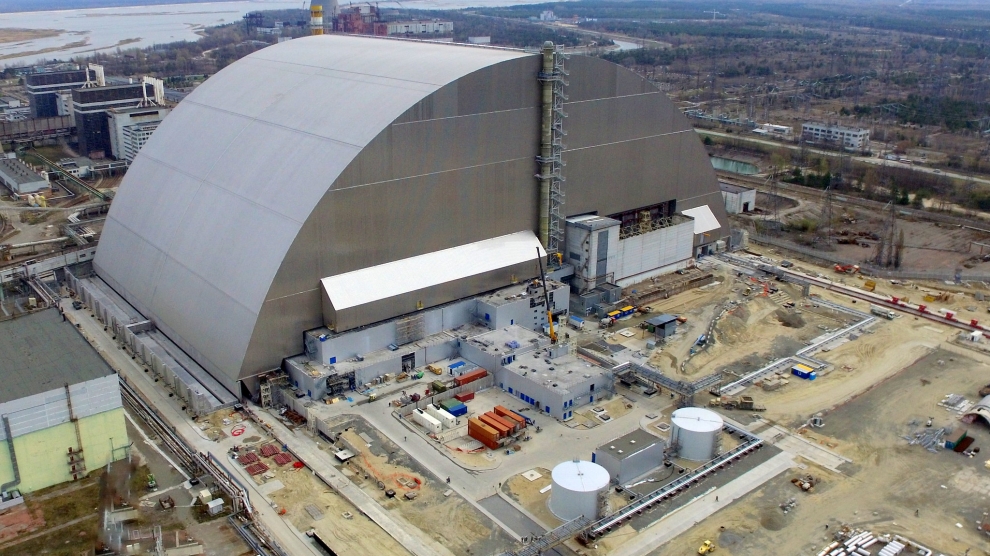A Russian drone with a high-explosive warhead struck the protective shelter covering the destroyed Unit 4 of the Chornobyl Nuclear Power Plant in Kyiv Oblast overnight on 14 February, President Volodymyr Zelenskyy reported. The attack caused significant damage to the structure, though authorities confirmed no increase in radiation levels.
Ukraine's State Nuclear Regulatory Inspectorate of Ukraine reported the strike occurred at 01:54, hitting the New Safe Confinement structure. IAEA experts permanently stationed at the site documented the incident, with further assessment of the impact on the shelter's safety pending.
The agency said as of 8:00 there was no change in radiation levels at the facility.
Chornobyl NPP's New Safe Confinement is a protective structure, built through international cooperation with European countries and the US. It contains radiation from the reactor unit 4, which was destroyed in a technological disaster in 1986, when Ukraine was still under the control of the USSR.
Speaking at the Munich Security Conference, Zelenskyy revealed the drone flew at an altitude of 85 meters, enabling it to avoid radar detection.
"This allows us to say they did this deliberately," Zelenskyy told journalists.
The Chornobyl NPP area borders Belarus, but Zelenskyy did not clarify whether the Russian drone passed through Belarus before striking the decommissioned plant.
Update: UN's nuclear watchdog IAEA shared photos of the aftermath of the Russian strike on the Chornobyl NPP's safe confinement:
Part of massive Russian nighttime drone attack
The Ukrainian Air Force reported that from 19:30 on 13 February, Russian forces launched 133 attack drones, including Shahed-type UAVs and various decoy drones, from multiple launch sites in Russia: Millerovo, Kursk, Bryansk, Shatalovo, and Primorsko-Akhtarsk.
Ukrainian air defenses, including aviation, anti-aircraft missile forces, electronic warfare units, and mobile fire groups of the Air Force and Defense Forces, intercepted 73 attack drones. The drones were shot down over Kharkiv, Poltava, Sumy, Cherkasy, Chernihiv, Kirovohrad, Zhytomyr, Khmelnytskyi, Zaporizhzhia, Mykolaiv, and Odesa oblasts. Additionally, 58 Russian decoy drones disappeared from radars without negative consequences.
The Air Force's figures suggest that at least two drones might have reached theor targets.
According to the Air Force, the attacks caused damage in Kyiv, Sumy, Chernihiv, Odesa, and Kharkiv oblasts.
Bombs and drones hurt civilians
Local authorities reported civilian casualties and damage from Russian bomb and drone strikes.
In Preobrazhenka, Zaporizhzhia Oblast, Russian forces struck with six guided bombs, destroying residential buildings. Regional administration head Ivan Fedorov reported that rescue workers recovered the body of a 50-year-old woman from the rubble.
In Sumy, a Russian drone attack injured a 45-year-old man and caused a fire in an outbuilding on the city's outskirts, according to the Sumy City Council. Police opened a criminal investigation into the attack.
In another incident in Sumy Oblast, Russian forces struck the Khotyn community with guided bombs, injuring three people and damaging a healthcare facility, the Oblast Military Administration reported.
Related:
- Russian bombs injure seven civilians in Zolochiv, including a 12-year-old and a 93-year-old
- Zelenskyy: Russia launches over 1,260 aerial bombs at Ukraine in one week
- Russia attacks Ukraine with 151 drones in overnight attack, at least 7 might reach targets
- UN nuclear watchdog board condemns Russian attacks on Ukraine’s energy grid, failing to mention Russia
- Three Ukrainian nuclear plants back online after Russian strikes
- Chernobyl: a disaster that still overwhelms us all
- Chornobyl Deadly Legacy: 35 years on

